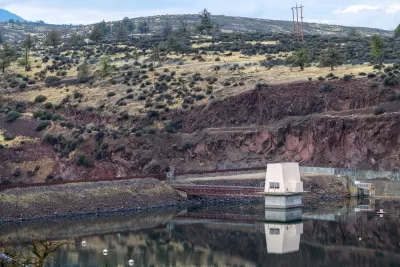Four dams are coming down along the Klamath River. The final decision to remove the dams is a milestone political and legal victory for indigenous tribes living in Southern Oregon and Northern California.

The largest dam removal project in U.S. history has cleared its final hurdle on the Klamath River in Oregon and California. The Iron Gate Dam, J.C. Boyle Dam, and Copco dams #1 and #2 will soon be history.
“The Federal Energy Regulatory Commission voted Thursday to allow the license of four dams on the Klamath River to lapse,” reports Kurtis Alexander for the San Francisco Chronicle [paywall] to report the historic news.
“The vote by federal regulators opens the door for the first of the four hydroelectric dams to come down next year in what has been a two-decade effort to liberate the once mighty river that spans southern Oregon and Northern California,” adds Alexander.
Additional coverage of the news is available from the Associated Press and High County News.
“After a grueling 20 years of environmental impact statements, scientific studies, negotiations with stakeholders and advocacy from the tribes and their conservationist allies — people who, as Hoopa Valley Tribe Chairman Joe Davis said, ‘poured their blood, sweat and tears into making this happen’ — the vote is the final green light everyone’s been waiting for. With FERC’s laborious approval process now concluded, dam removal can begin, launching what is expected to be the biggest river restoration project in U.S. history,” reports B. ‘Toastie’ Oaster for High Country News.
Oaster provides additional about the remaining steps in the dam removal process: “The next legal steps are largely technical. As a result of the vote, FERC is ordering the surrender of the Lower Klamath Project License, which is currently held by energy company PacifiCorp. That license will be transferred to the entities in charge of dam removal: the states of Oregon and California, and the Klamath River Renewal Corporation, a nonprofit created to oversee dam removal that is made up of tribal, state and conservation group representatives.”
As noted by Oaster, the stage for FERC’s historic vote was set by FERC’s August release of a final environmental impact statement.
Planetizen has been covering the Klamath River dam saga since 2007, with updates oscillating between progress and setbacks for the dam removal in 2008, 2016 (and 2016 again), 2018, and 2022. The Klamath River made national news in 2002 when a fish kill left 34,000 dead salmon lining the banks of the river.
More details on what’s next in the dam removal process are included at the link below.
FULL STORY: The Klamath dams are coming down

Study: Maui’s Plan to Convert Vacation Rentals to Long-Term Housing Could Cause Nearly $1 Billion Economic Loss
The plan would reduce visitor accommodation by 25,% resulting in 1,900 jobs lost.

North Texas Transit Leaders Tout Benefits of TOD for Growing Region
At a summit focused on transit-oriented development, policymakers discussed how North Texas’ expanded light rail system can serve as a tool for economic growth.

Why Should We Subsidize Public Transportation?
Many public transit agencies face financial stress due to rising costs, declining fare revenue, and declining subsidies. Transit advocates must provide a strong business case for increasing public transit funding.

Invasive Insect Threatens Minnesota’s Ash Forests
The Emerald Ash Borer is a rapidly spreading invasive pest threatening Minnesota’s ash trees, and homeowners are encouraged to plant diverse replacement species, avoid moving ash firewood, and monitor for signs of infestation.

Agreement Keeps NYC Congestion Pricing Alive Through Summer
The tolling program will continue while a court considers the city’s lawsuit against the Trump administration.

Private Donations Propel Early Restoration of Palisades Playground
Los Angeles has secured over $1.3 million in private funding to restore the Pacific Palisades playground months ahead of schedule, creating a modern, accessible space that supports community healing after recent wildfires.
Urban Design for Planners 1: Software Tools
This six-course series explores essential urban design concepts using open source software and equips planners with the tools they need to participate fully in the urban design process.
Planning for Universal Design
Learn the tools for implementing Universal Design in planning regulations.
Ascent Environmental
Borough of Carlisle
Institute for Housing and Urban Development Studies (IHS)
City of Grandview
Harvard GSD Executive Education
Toledo-Lucas County Plan Commissions
Salt Lake City
NYU Wagner Graduate School of Public Service



























